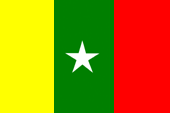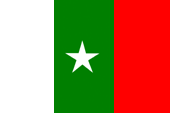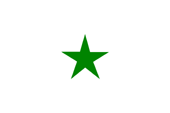Casamance |
|
|
|
| Übersicht – Contents: | |
Casamance |
|
|
|
| Übersicht – Contents: | |
Flaggen – Flags: |
|
 |
1983, Nationalflagge – national flag, Seitenverhältnis – ratio = 2:3, Quelle/Source nach/by: Flags of the World |
 |
1988, Nationalflagge – national flag, Seitenverhältnis – ratio = 2:3, Quelle/Source nach/by: Flags of the World |
 |
2001, Nationalflagge – national flag, Seitenverhältnis – ratio = 2:3, Quelle/Source nach/by: Flags of the World |
Bedeutung/Ursprung der Flagge – Meaning/Origin of the Flag: |
|
| Die ursprüngliche Flagge der Casamance ist die Flagge der Partei MFDC (Mouvement des Forces Démocratiques de la Casamance). Sie wurde 1983 angenommen. | The initial flag of the Casamance is the flag of the Partei MFDC (Mouvement des Forces Démocratiques de la Casamance). It was adoped in 1983. |
| Die Gestaltung der Flagge von 1983 geht eindeutig auf die Flagge von Senegal zurück, von dem die Casamance sich abtrennen will. | The design of the flag of 1983 has its roots clearly in the flag of Senegal from which the Casamance wants to separate. |
| Sie zeigte die Aufteilung in drei senkrechte Streifen in den panafrikanischen Farben und im mittleren Feld einen Stern, hier jedoch in weiß. | It showed the division in three vertical stripes in the Pan-African colours colours and in the middle field a star, but here in white. |
| Gelb steht für Reichtum und Wohlstand, Grün für Wälder und Landwirtschaft, Rot für das Blut, der weiße Stern für das Volk in der Casamance. | Yellow stands for wealth and prosperity, green for woods and agriculture, red for blood. The white star represents the people of the Casamance. |
| Die Farben Grün, Gelb und Rot sind die panafrikanischen Farben. Etwa 1900 setzte die Panafrika-Bewegung ein, die Gemeinsamkeiten aller Menschen mit schwarzer Hautfarbe hervorheben wollte. Der Farbendreiklang Grün-Gelb-Rot, den viele afrikanische und auch amerikanische Staaten nach Erlangung ihrer Unabhängigkeit in ihre Flaggen übernahmen, steht für die politische Einheit Afrikas, ja aller Schwarzen. Das erste Land war Ghana im Jahr 1957. Als Ursprung gelten die Landesfarben von Athiopien (Abessinien), dem ältesten unabhängigen Staat Afrikas. | The colours green,
yellow and red are the Pan-African colours. The Pan-African-Movement had its beginnings
perhaps in 1900, which wants to emphasize the common goals of all black people. The colour-triad green-yellow-red, which are used by many African and even American countries in their flags after independence, stands for the political unity of Africa, of all black People. The first country was Ghana in 1957. As the origin, the colours of Ethiopia (Abessinia), the oldest independent state in Africa, apply. |
| Im Jahre 1988 wurde der gelbe Streifen offiziell durch einen weißen Streifen ersetzt. Weiß steht für Frieden, Gerechtigkeit, Freiheit und Einheit. | In the year 1988 the yellow stripe was replaced by a white stripe. The colour white stands for peace, justice, freedom and unity. |
| Im Jahre 2001 spaltete sich die MFDC auf. Die Fraktion, welche den Kampf für einen unabhängige Casamance unter Waffen fortsetzen will, zeigt heute ein weißes Tuch mit einem grünen Stern in der Mitte. | In 2001 the MFDC splited in fractions. Those fraction, which wants to continue the fight for an independent Casamance under arms, shows today a white bunting with a green star in the middle. |
| Quelle/Source: Flags of the World, Die Welt der Flaggen | |
| interaktive Landkarte – interactive Map: |
|
Zahlen und Fakten – Numbers and Facts: |
|
|
|
|
|
|
|
|
|
|
|
|
|
|
|
|
|
Geschichte: |
| 14.–15.
Jahrhundert · Teile der heutigen Casamance gehören zum Staat Mali 1460 · portugiesische Händler errichten am Fluss Cacheu im heutigen Guinea-Bissau den Stützpunkt Cacheu, in der Folgezeit portugiesischer Einfluss bis an den Casamance-Fluss 17.–19. Jahrhundert · das Gebiet der Casamance wird nicht kolonial erschlossen, jedoch gewisser britischer und portugiesischer Einfluss 1886 · Frankreich gliedert die Casamance in seine Kolonie Senegal ein 1889 · Grenzvertrag mit Großbritannien zu Gambia 1895 · Bildung des Generalgouvernements Französisch-Westafrika 1902 · Bildung der Kolonialföderation Französisch-Westafrika bestehend aus: 1.) Mauretanien – Französisch-Sudan – Niger-Kolonie – Obervolta, 2.) Senegal, 3.) Dahomey, 4.) Elfenbeinküste, 5.) Französisch-Guinea 1947 · Gründung der Partei MFDC (Mouvement des Forces Démocratiques de la Casamance) 20.06.1960 · Senegal wird ein unabhängiger Staat 1980–2000 · Herrschaft des Präsidenten Abdou Diouf im Senegal 1982 · Inhaftierung der Führung der MFDC 1990–1993 · Casamance-Konflikt, die Region Casamance versucht sich von Senegal zu trennen, die MFDC führt den bewaffneten Kampf an, Unterstützung durch Truppen aus Guinea-Bissau 1994 · Friedensabkommen zwischen MFDC und der Regierung von Senegal 1995 · weil in den Friendsabkommen mit Senegal keine Autonomie für die Casamance vorgesehen ist, nehmen Teile der MFDC den bewaffneten Kampf wieder auf 2001 · Friedensabkommen zwischen MFDC und der Regierung von Senegal 2002 · weil in den Friendsabkommen mit Senegal erneut keine Autonomie für die Casamance vorgesehen ist, spaltet sich die MFDC auf, Teile der MFDC nehmen den bewaffneten Kampf gegen Senegal wieder auf, es kommt zu Kämpfen zwischen den MFDC-Fraktionen |
History: |
| 14th–15th
century · parts of the today’s Casamance belong to the Mali-State 1460 · Portugese merchants establish at the Cacheu River in the today's Guinea-Bissau the base of Cacheu, in the afteryears waxing portugese influence towards the Casamance River 17th–19th century · the area of the Casamance becomes not colonially exploited, but special British and Portugese influence 1886 · France incorporates the Casamance into its colony of Senegal 1889 · border treaty with United Kingdom towards Gambia 1895 · establishment of the Government General French West Africa 1902 · establishment of the colonial federation of French West Africa consisting of: 1st) Mauritania – French Sudan – Niger Colony – Uppervolta, 2nd) Senegal, 3rd) Dahomey, 4th) Ivory Coast, 5th) French Guinea 1947 · foundation of the MFDC-Party (Mouvement des Forces Démocratiques de la Casamance) 20th of June 1960 · Senegal becomes an independent state 1980–2000 · rule of the President Abdou Diouf in Senegal 1982 · imprison of the command of the MFDC 1990–1993 · Casamance-Conflict, the region Casamance trys to separate from Senegal, the MFDC leads the armed struggle, support by troops of Guinea-Bissau 1994 · peace agreement of MFDC with the government of Senegal 1995 · because the peace agreement with Senegal contained none autonomy for Casamance parts of the MFDC continue the armed struggle 2001 · peace agreement of MFDC with the government of Senegal 2002 · because the peace agreement with Senegal contained none autonomy for Casamance the MFDC splits, parts of the MFDC continue the armed struggle against Senegal, there arise struggles between de MFDC-Fractions |
| Quelle/Source: Atlas zur Geschichte, Wikipedia (D), Flags of the World |
Ursprung des Landesnamens – Origin of the Country's Name: |
|
| Der Landesname "Casamance" geht auf den Casamance-Fluss zurück. Er ist die Lebensader des Landes. Der Name "Casamance" wurde von den Portugiesen eingeführt und leitet sich aus dem Manding-Wort "Cassamoukou" ab, was "Reis" bedeutet. Die Casamance ist also das "Reisland". Offenbar bietet der Fluss Casamance gute Voraussetzungen zu Reisanbau, denn das Land ist das bedeutendste Reisanbaugebiet der Region. | The name of the country "Casamance" has its roots in the Casamance River. He is the lifeline of the country. The name "Casamance" was introduced by the Portugese and derives from the Manding word "Cassamoukou", what means "rice". The Casamance is so the "rice land". Manifestly the River Casamance offers good conditions for rice-farming because the country is the most important rice-farming-zone in the region. |
| Es teilt sich geographisch in zwei Regionen, die Obere Casamance (Haute Casamance, Region Kolda) und die Untere Casamance (Basse Casamance, Region Ziguinchor). | It is geographical separated in two regions, the Upper Casamance (Haute Casamance, region of Kolda) and the Lower Casamance (Basse Casamance, region of Ziguinchor). |
| Quelle/Source: Wikipedia (D), Flags of the World, Länder der Erde | |